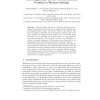Free Online Productivity Tools
i2Speak
i2Symbol
i2OCR
iTex2Img
iWeb2Print
iWeb2Shot
i2Type
iPdf2Split
iPdf2Merge
i2Bopomofo
i2Arabic
i2Style
i2Image
i2PDF
iLatex2Rtf
Sci2ools
ADHOCNOW
2008
Springer
2008
Springer
Novel Algorithms for the Network Lifetime Problem in Wireless Settings
Abstract. A wireless ad-hoc network is a collection of transceivers positioned in the plane. Each transceiver is equipped with a limited, nonreplenishable battery charge. The battery charge is then reduced after each transmission, depending on the transmission distance. One of the major problems in wireless network design is to route network traffic efficiently so as to maximize the network lifetime, i.e., the number of successful transmissions. This problem is known to be NP-Hard for a variety of network operations. In this paper we are interested in two fundamental types of transmissions, broadcast and data gathering. We provide polynomial time approximation algorithms, with guaranteed performance bounds, for the maximum lifetime problem under two communication models, omnidirectional and unidirectional antennas. We also consider an extended variant of the maximum lifetime problem, which simultaneously satisfies additional constraints, such as bounded hop-diameter and degree of the ...
ADHOCNOW 2008 | Battery Charge | Maximum Lifetime Problem | Wireless Ad-hoc Network | Wireless Networks |
| Added | 01 Jun 2010 |
| Updated | 01 Jun 2010 |
| Type | Conference |
| Year | 2008 |
| Where | ADHOCNOW |
| Authors | Michael Elkin, Yuval Lando, Zeev Nutov, Michael Segal, Hanan Shpungin |
Comments (0)

